Organisational Culture in Tourism, Hospitality, and Events
VerifiedAdded on 2023/04/20
|8
|2011
|471
Essay
AI Summary
This essay delves into the concept of organizational culture within the hospitality industry, defining it as the personality of an organization comprising values, norms, assumptions, and artifacts. It examines the positive aspects, such as transparent communication, fairness, integrity, and respect, exemplified by companies like Marriott Hotels. Conversely, it addresses negative characteristics like poor communication, strict rules, and unethical wage practices, using Park Plaza Hotel as an example. The essay further discusses the role of recruitment, development, and retention practices in shaping organizational culture, emphasizing the importance of ethical selection, fair rewards, and employee training. Finally, it highlights the crucial role of leadership in shaping a positive organizational culture by sharing vision and motivating employees towards their goals, ultimately influencing behavior and attitudes within the organization. Desklib provides access to similar essays and study resources for students.
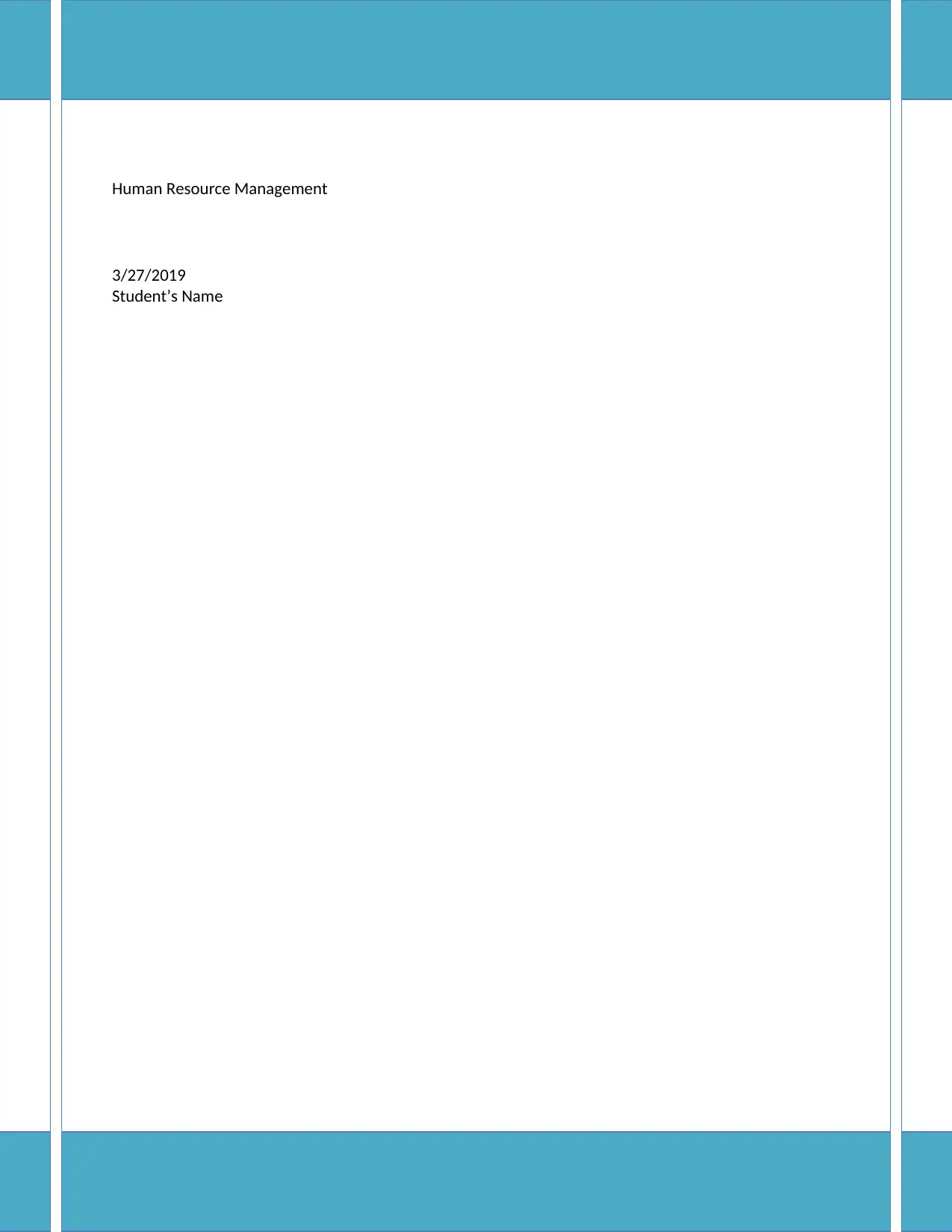
Human Resource Management
3/27/2019
Student’s Name
3/27/2019
Student’s Name
Paraphrase This Document
Need a fresh take? Get an instant paraphrase of this document with our AI Paraphraser
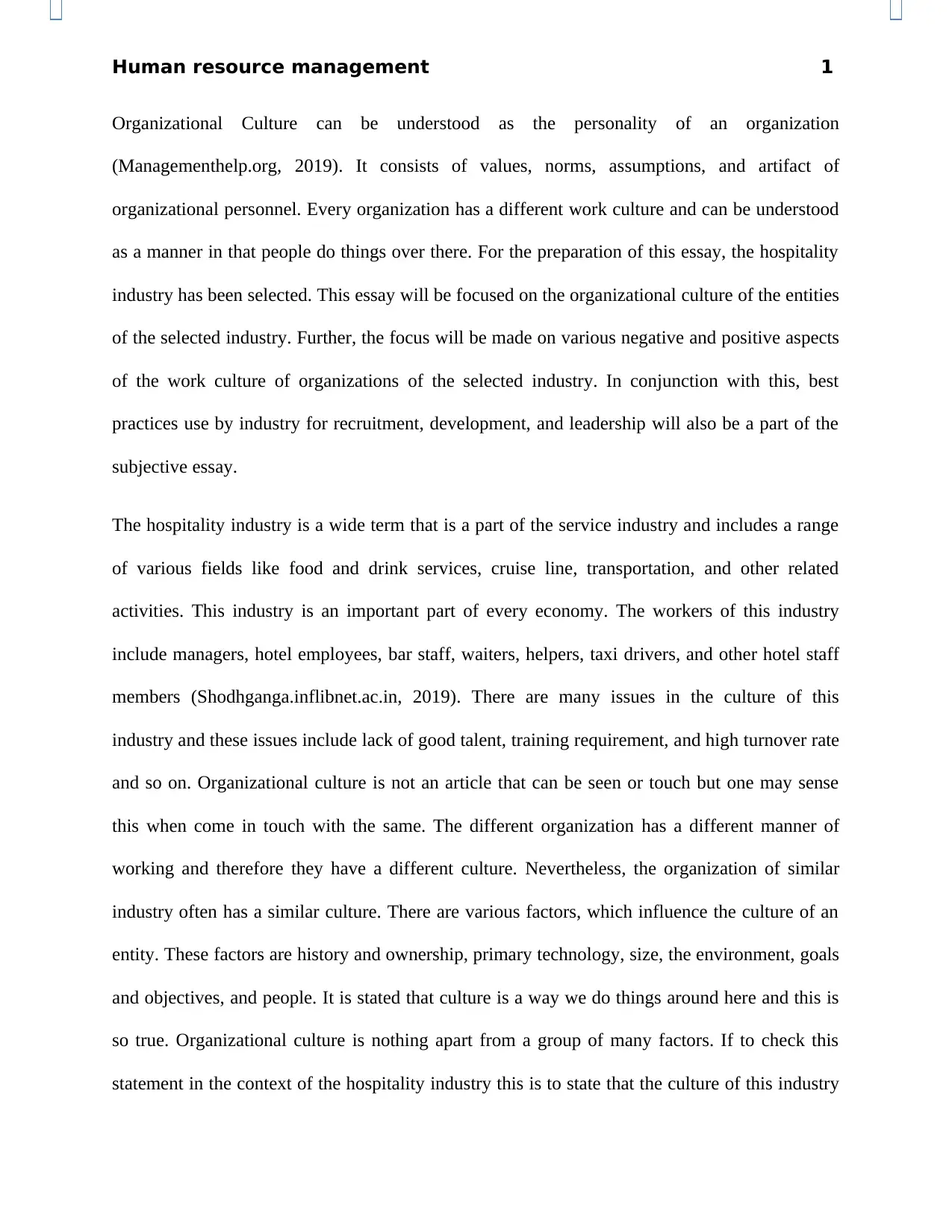
Human resource management 1
Organizational Culture can be understood as the personality of an organization
(Managementhelp.org, 2019). It consists of values, norms, assumptions, and artifact of
organizational personnel. Every organization has a different work culture and can be understood
as a manner in that people do things over there. For the preparation of this essay, the hospitality
industry has been selected. This essay will be focused on the organizational culture of the entities
of the selected industry. Further, the focus will be made on various negative and positive aspects
of the work culture of organizations of the selected industry. In conjunction with this, best
practices use by industry for recruitment, development, and leadership will also be a part of the
subjective essay.
The hospitality industry is a wide term that is a part of the service industry and includes a range
of various fields like food and drink services, cruise line, transportation, and other related
activities. This industry is an important part of every economy. The workers of this industry
include managers, hotel employees, bar staff, waiters, helpers, taxi drivers, and other hotel staff
members (Shodhganga.inflibnet.ac.in, 2019). There are many issues in the culture of this
industry and these issues include lack of good talent, training requirement, and high turnover rate
and so on. Organizational culture is not an article that can be seen or touch but one may sense
this when come in touch with the same. The different organization has a different manner of
working and therefore they have a different culture. Nevertheless, the organization of similar
industry often has a similar culture. There are various factors, which influence the culture of an
entity. These factors are history and ownership, primary technology, size, the environment, goals
and objectives, and people. It is stated that culture is a way we do things around here and this is
so true. Organizational culture is nothing apart from a group of many factors. If to check this
statement in the context of the hospitality industry this is to state that the culture of this industry
Organizational Culture can be understood as the personality of an organization
(Managementhelp.org, 2019). It consists of values, norms, assumptions, and artifact of
organizational personnel. Every organization has a different work culture and can be understood
as a manner in that people do things over there. For the preparation of this essay, the hospitality
industry has been selected. This essay will be focused on the organizational culture of the entities
of the selected industry. Further, the focus will be made on various negative and positive aspects
of the work culture of organizations of the selected industry. In conjunction with this, best
practices use by industry for recruitment, development, and leadership will also be a part of the
subjective essay.
The hospitality industry is a wide term that is a part of the service industry and includes a range
of various fields like food and drink services, cruise line, transportation, and other related
activities. This industry is an important part of every economy. The workers of this industry
include managers, hotel employees, bar staff, waiters, helpers, taxi drivers, and other hotel staff
members (Shodhganga.inflibnet.ac.in, 2019). There are many issues in the culture of this
industry and these issues include lack of good talent, training requirement, and high turnover rate
and so on. Organizational culture is not an article that can be seen or touch but one may sense
this when come in touch with the same. The different organization has a different manner of
working and therefore they have a different culture. Nevertheless, the organization of similar
industry often has a similar culture. There are various factors, which influence the culture of an
entity. These factors are history and ownership, primary technology, size, the environment, goals
and objectives, and people. It is stated that culture is a way we do things around here and this is
so true. Organizational culture is nothing apart from a group of many factors. If to check this
statement in the context of the hospitality industry this is to state that the culture of this industry
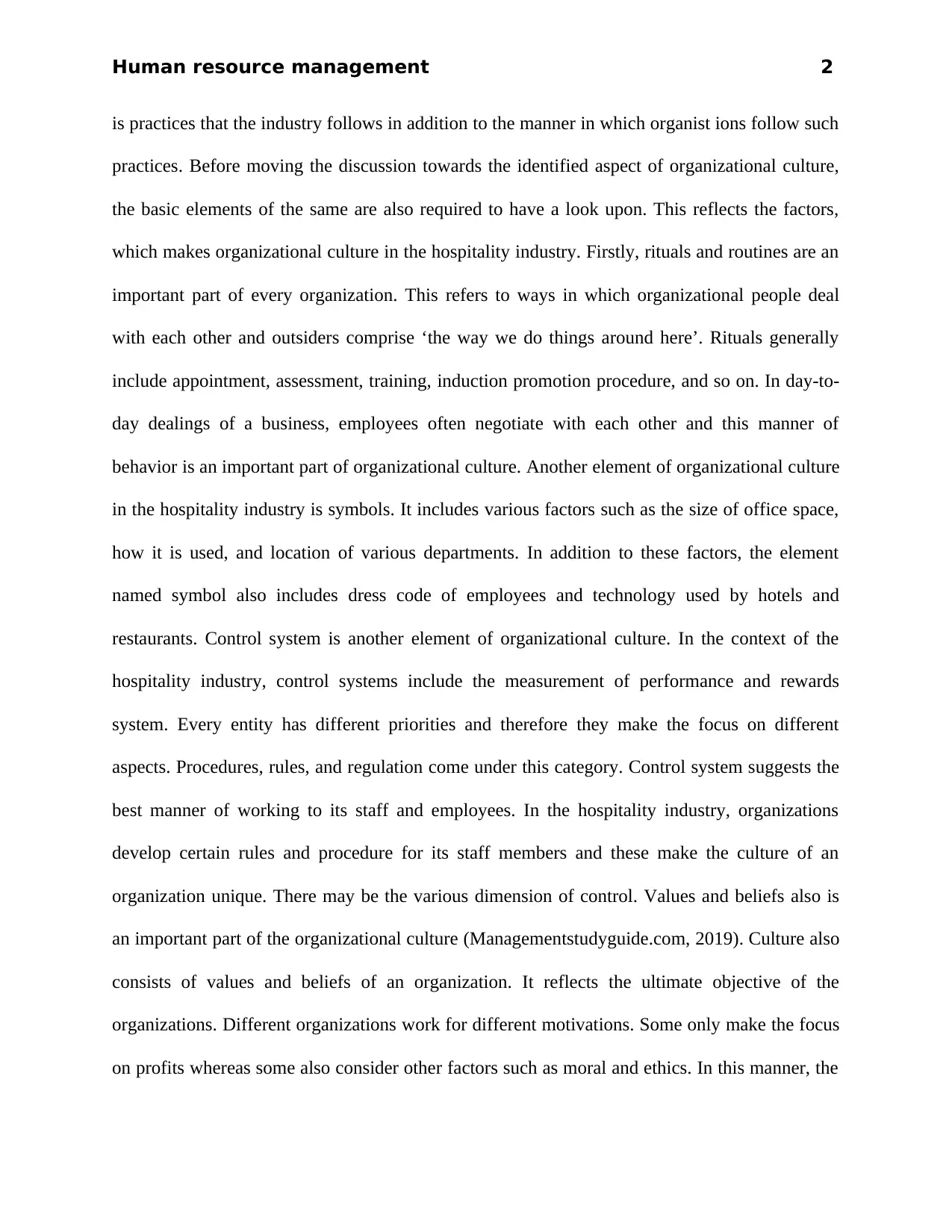
Human resource management 2
is practices that the industry follows in addition to the manner in which organist ions follow such
practices. Before moving the discussion towards the identified aspect of organizational culture,
the basic elements of the same are also required to have a look upon. This reflects the factors,
which makes organizational culture in the hospitality industry. Firstly, rituals and routines are an
important part of every organization. This refers to ways in which organizational people deal
with each other and outsiders comprise ‘the way we do things around here’. Rituals generally
include appointment, assessment, training, induction promotion procedure, and so on. In day-to-
day dealings of a business, employees often negotiate with each other and this manner of
behavior is an important part of organizational culture. Another element of organizational culture
in the hospitality industry is symbols. It includes various factors such as the size of office space,
how it is used, and location of various departments. In addition to these factors, the element
named symbol also includes dress code of employees and technology used by hotels and
restaurants. Control system is another element of organizational culture. In the context of the
hospitality industry, control systems include the measurement of performance and rewards
system. Every entity has different priorities and therefore they make the focus on different
aspects. Procedures, rules, and regulation come under this category. Control system suggests the
best manner of working to its staff and employees. In the hospitality industry, organizations
develop certain rules and procedure for its staff members and these make the culture of an
organization unique. There may be the various dimension of control. Values and beliefs also is
an important part of the organizational culture (Managementstudyguide.com, 2019). Culture also
consists of values and beliefs of an organization. It reflects the ultimate objective of the
organizations. Different organizations work for different motivations. Some only make the focus
on profits whereas some also consider other factors such as moral and ethics. In this manner, the
is practices that the industry follows in addition to the manner in which organist ions follow such
practices. Before moving the discussion towards the identified aspect of organizational culture,
the basic elements of the same are also required to have a look upon. This reflects the factors,
which makes organizational culture in the hospitality industry. Firstly, rituals and routines are an
important part of every organization. This refers to ways in which organizational people deal
with each other and outsiders comprise ‘the way we do things around here’. Rituals generally
include appointment, assessment, training, induction promotion procedure, and so on. In day-to-
day dealings of a business, employees often negotiate with each other and this manner of
behavior is an important part of organizational culture. Another element of organizational culture
in the hospitality industry is symbols. It includes various factors such as the size of office space,
how it is used, and location of various departments. In addition to these factors, the element
named symbol also includes dress code of employees and technology used by hotels and
restaurants. Control system is another element of organizational culture. In the context of the
hospitality industry, control systems include the measurement of performance and rewards
system. Every entity has different priorities and therefore they make the focus on different
aspects. Procedures, rules, and regulation come under this category. Control system suggests the
best manner of working to its staff and employees. In the hospitality industry, organizations
develop certain rules and procedure for its staff members and these make the culture of an
organization unique. There may be the various dimension of control. Values and beliefs also is
an important part of the organizational culture (Managementstudyguide.com, 2019). Culture also
consists of values and beliefs of an organization. It reflects the ultimate objective of the
organizations. Different organizations work for different motivations. Some only make the focus
on profits whereas some also consider other factors such as moral and ethics. In this manner, the
⊘ This is a preview!⊘
Do you want full access?
Subscribe today to unlock all pages.

Trusted by 1+ million students worldwide
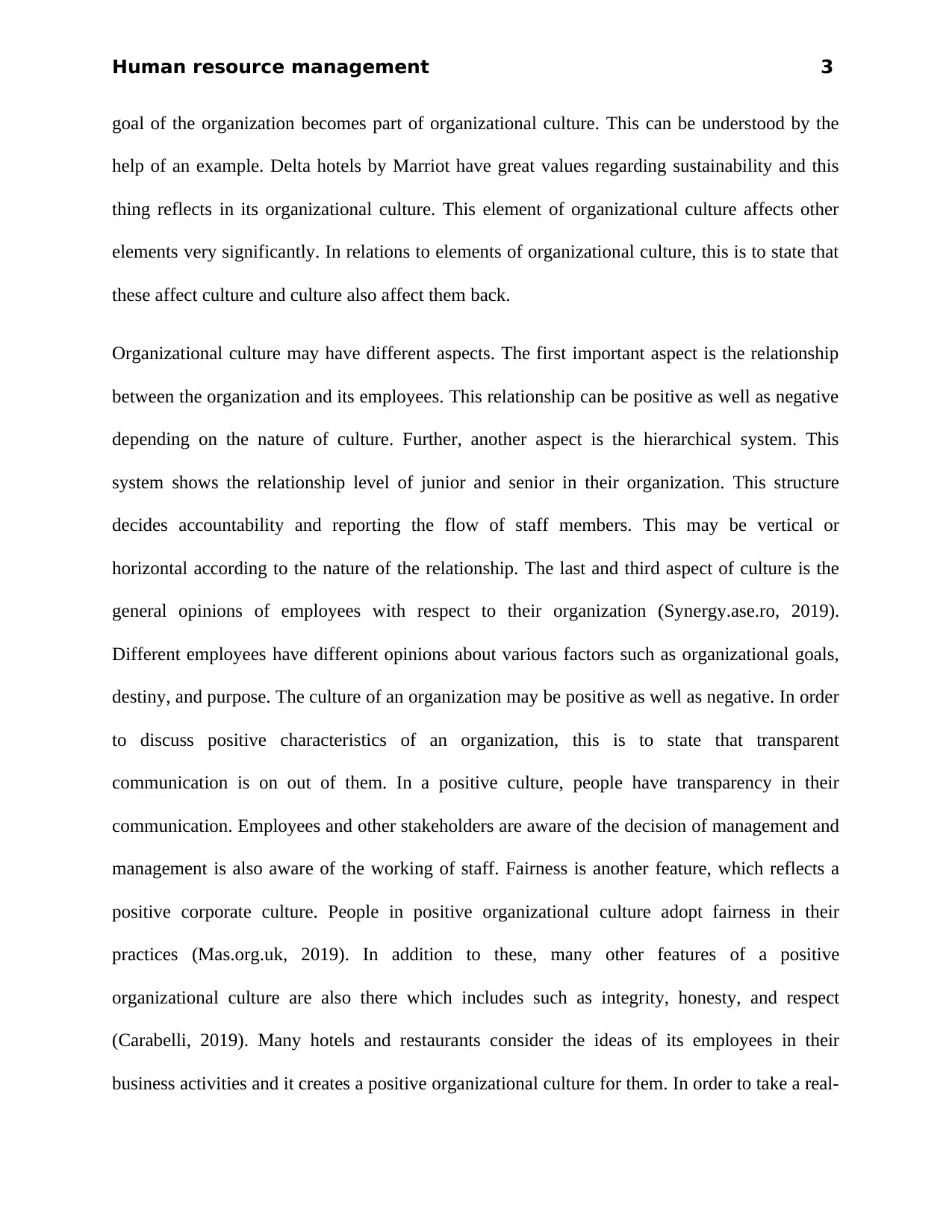
Human resource management 3
goal of the organization becomes part of organizational culture. This can be understood by the
help of an example. Delta hotels by Marriot have great values regarding sustainability and this
thing reflects in its organizational culture. This element of organizational culture affects other
elements very significantly. In relations to elements of organizational culture, this is to state that
these affect culture and culture also affect them back.
Organizational culture may have different aspects. The first important aspect is the relationship
between the organization and its employees. This relationship can be positive as well as negative
depending on the nature of culture. Further, another aspect is the hierarchical system. This
system shows the relationship level of junior and senior in their organization. This structure
decides accountability and reporting the flow of staff members. This may be vertical or
horizontal according to the nature of the relationship. The last and third aspect of culture is the
general opinions of employees with respect to their organization (Synergy.ase.ro, 2019).
Different employees have different opinions about various factors such as organizational goals,
destiny, and purpose. The culture of an organization may be positive as well as negative. In order
to discuss positive characteristics of an organization, this is to state that transparent
communication is on out of them. In a positive culture, people have transparency in their
communication. Employees and other stakeholders are aware of the decision of management and
management is also aware of the working of staff. Fairness is another feature, which reflects a
positive corporate culture. People in positive organizational culture adopt fairness in their
practices (Mas.org.uk, 2019). In addition to these, many other features of a positive
organizational culture are also there which includes such as integrity, honesty, and respect
(Carabelli, 2019). Many hotels and restaurants consider the ideas of its employees in their
business activities and it creates a positive organizational culture for them. In order to take a real-
goal of the organization becomes part of organizational culture. This can be understood by the
help of an example. Delta hotels by Marriot have great values regarding sustainability and this
thing reflects in its organizational culture. This element of organizational culture affects other
elements very significantly. In relations to elements of organizational culture, this is to state that
these affect culture and culture also affect them back.
Organizational culture may have different aspects. The first important aspect is the relationship
between the organization and its employees. This relationship can be positive as well as negative
depending on the nature of culture. Further, another aspect is the hierarchical system. This
system shows the relationship level of junior and senior in their organization. This structure
decides accountability and reporting the flow of staff members. This may be vertical or
horizontal according to the nature of the relationship. The last and third aspect of culture is the
general opinions of employees with respect to their organization (Synergy.ase.ro, 2019).
Different employees have different opinions about various factors such as organizational goals,
destiny, and purpose. The culture of an organization may be positive as well as negative. In order
to discuss positive characteristics of an organization, this is to state that transparent
communication is on out of them. In a positive culture, people have transparency in their
communication. Employees and other stakeholders are aware of the decision of management and
management is also aware of the working of staff. Fairness is another feature, which reflects a
positive corporate culture. People in positive organizational culture adopt fairness in their
practices (Mas.org.uk, 2019). In addition to these, many other features of a positive
organizational culture are also there which includes such as integrity, honesty, and respect
(Carabelli, 2019). Many hotels and restaurants consider the ideas of its employees in their
business activities and it creates a positive organizational culture for them. In order to take a real-
Paraphrase This Document
Need a fresh take? Get an instant paraphrase of this document with our AI Paraphraser
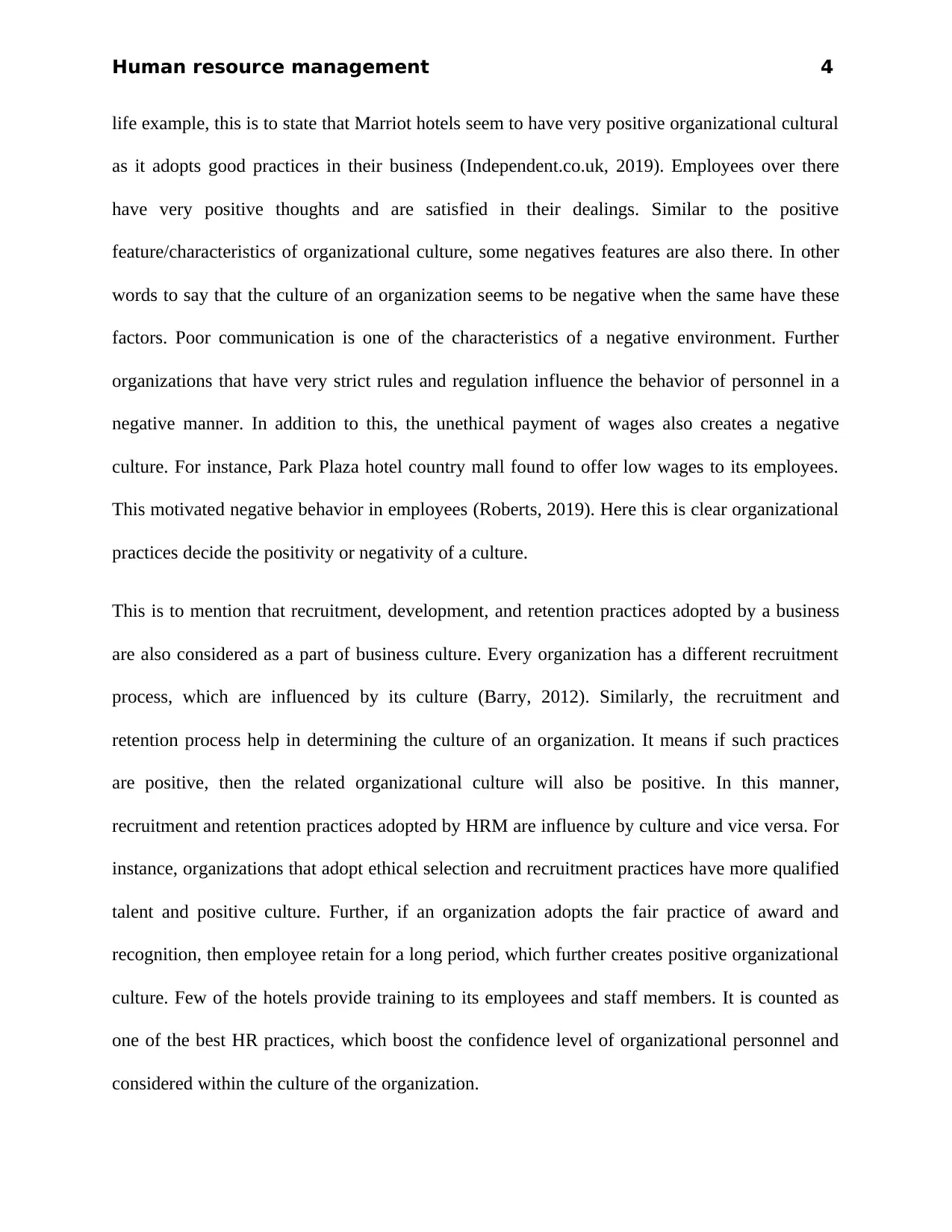
Human resource management 4
life example, this is to state that Marriot hotels seem to have very positive organizational cultural
as it adopts good practices in their business (Independent.co.uk, 2019). Employees over there
have very positive thoughts and are satisfied in their dealings. Similar to the positive
feature/characteristics of organizational culture, some negatives features are also there. In other
words to say that the culture of an organization seems to be negative when the same have these
factors. Poor communication is one of the characteristics of a negative environment. Further
organizations that have very strict rules and regulation influence the behavior of personnel in a
negative manner. In addition to this, the unethical payment of wages also creates a negative
culture. For instance, Park Plaza hotel country mall found to offer low wages to its employees.
This motivated negative behavior in employees (Roberts, 2019). Here this is clear organizational
practices decide the positivity or negativity of a culture.
This is to mention that recruitment, development, and retention practices adopted by a business
are also considered as a part of business culture. Every organization has a different recruitment
process, which are influenced by its culture (Barry, 2012). Similarly, the recruitment and
retention process help in determining the culture of an organization. It means if such practices
are positive, then the related organizational culture will also be positive. In this manner,
recruitment and retention practices adopted by HRM are influence by culture and vice versa. For
instance, organizations that adopt ethical selection and recruitment practices have more qualified
talent and positive culture. Further, if an organization adopts the fair practice of award and
recognition, then employee retain for a long period, which further creates positive organizational
culture. Few of the hotels provide training to its employees and staff members. It is counted as
one of the best HR practices, which boost the confidence level of organizational personnel and
considered within the culture of the organization.
life example, this is to state that Marriot hotels seem to have very positive organizational cultural
as it adopts good practices in their business (Independent.co.uk, 2019). Employees over there
have very positive thoughts and are satisfied in their dealings. Similar to the positive
feature/characteristics of organizational culture, some negatives features are also there. In other
words to say that the culture of an organization seems to be negative when the same have these
factors. Poor communication is one of the characteristics of a negative environment. Further
organizations that have very strict rules and regulation influence the behavior of personnel in a
negative manner. In addition to this, the unethical payment of wages also creates a negative
culture. For instance, Park Plaza hotel country mall found to offer low wages to its employees.
This motivated negative behavior in employees (Roberts, 2019). Here this is clear organizational
practices decide the positivity or negativity of a culture.
This is to mention that recruitment, development, and retention practices adopted by a business
are also considered as a part of business culture. Every organization has a different recruitment
process, which are influenced by its culture (Barry, 2012). Similarly, the recruitment and
retention process help in determining the culture of an organization. It means if such practices
are positive, then the related organizational culture will also be positive. In this manner,
recruitment and retention practices adopted by HRM are influence by culture and vice versa. For
instance, organizations that adopt ethical selection and recruitment practices have more qualified
talent and positive culture. Further, if an organization adopts the fair practice of award and
recognition, then employee retain for a long period, which further creates positive organizational
culture. Few of the hotels provide training to its employees and staff members. It is counted as
one of the best HR practices, which boost the confidence level of organizational personnel and
considered within the culture of the organization.
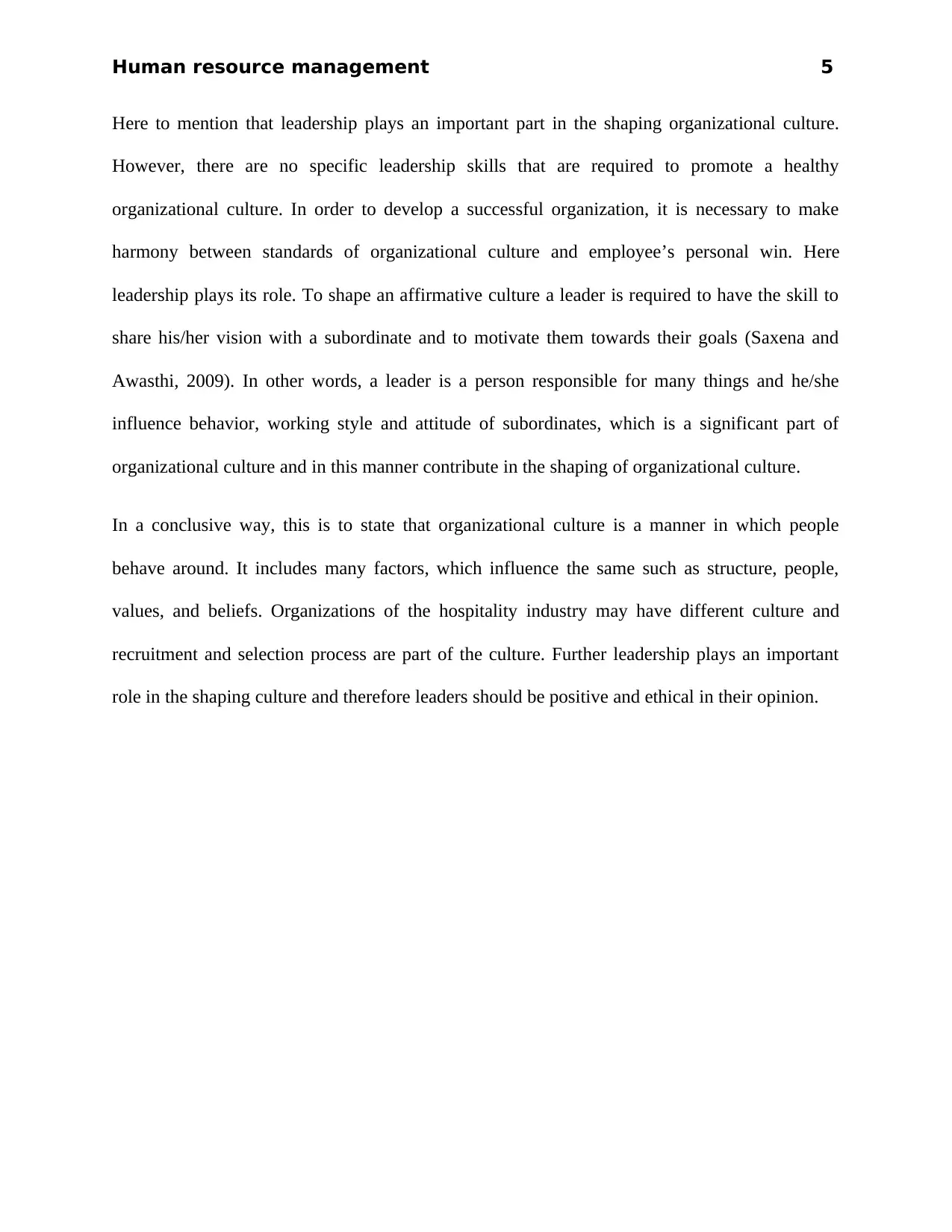
Human resource management 5
Here to mention that leadership plays an important part in the shaping organizational culture.
However, there are no specific leadership skills that are required to promote a healthy
organizational culture. In order to develop a successful organization, it is necessary to make
harmony between standards of organizational culture and employee’s personal win. Here
leadership plays its role. To shape an affirmative culture a leader is required to have the skill to
share his/her vision with a subordinate and to motivate them towards their goals (Saxena and
Awasthi, 2009). In other words, a leader is a person responsible for many things and he/she
influence behavior, working style and attitude of subordinates, which is a significant part of
organizational culture and in this manner contribute in the shaping of organizational culture.
In a conclusive way, this is to state that organizational culture is a manner in which people
behave around. It includes many factors, which influence the same such as structure, people,
values, and beliefs. Organizations of the hospitality industry may have different culture and
recruitment and selection process are part of the culture. Further leadership plays an important
role in the shaping culture and therefore leaders should be positive and ethical in their opinion.
Here to mention that leadership plays an important part in the shaping organizational culture.
However, there are no specific leadership skills that are required to promote a healthy
organizational culture. In order to develop a successful organization, it is necessary to make
harmony between standards of organizational culture and employee’s personal win. Here
leadership plays its role. To shape an affirmative culture a leader is required to have the skill to
share his/her vision with a subordinate and to motivate them towards their goals (Saxena and
Awasthi, 2009). In other words, a leader is a person responsible for many things and he/she
influence behavior, working style and attitude of subordinates, which is a significant part of
organizational culture and in this manner contribute in the shaping of organizational culture.
In a conclusive way, this is to state that organizational culture is a manner in which people
behave around. It includes many factors, which influence the same such as structure, people,
values, and beliefs. Organizations of the hospitality industry may have different culture and
recruitment and selection process are part of the culture. Further leadership plays an important
role in the shaping culture and therefore leaders should be positive and ethical in their opinion.
⊘ This is a preview!⊘
Do you want full access?
Subscribe today to unlock all pages.

Trusted by 1+ million students worldwide
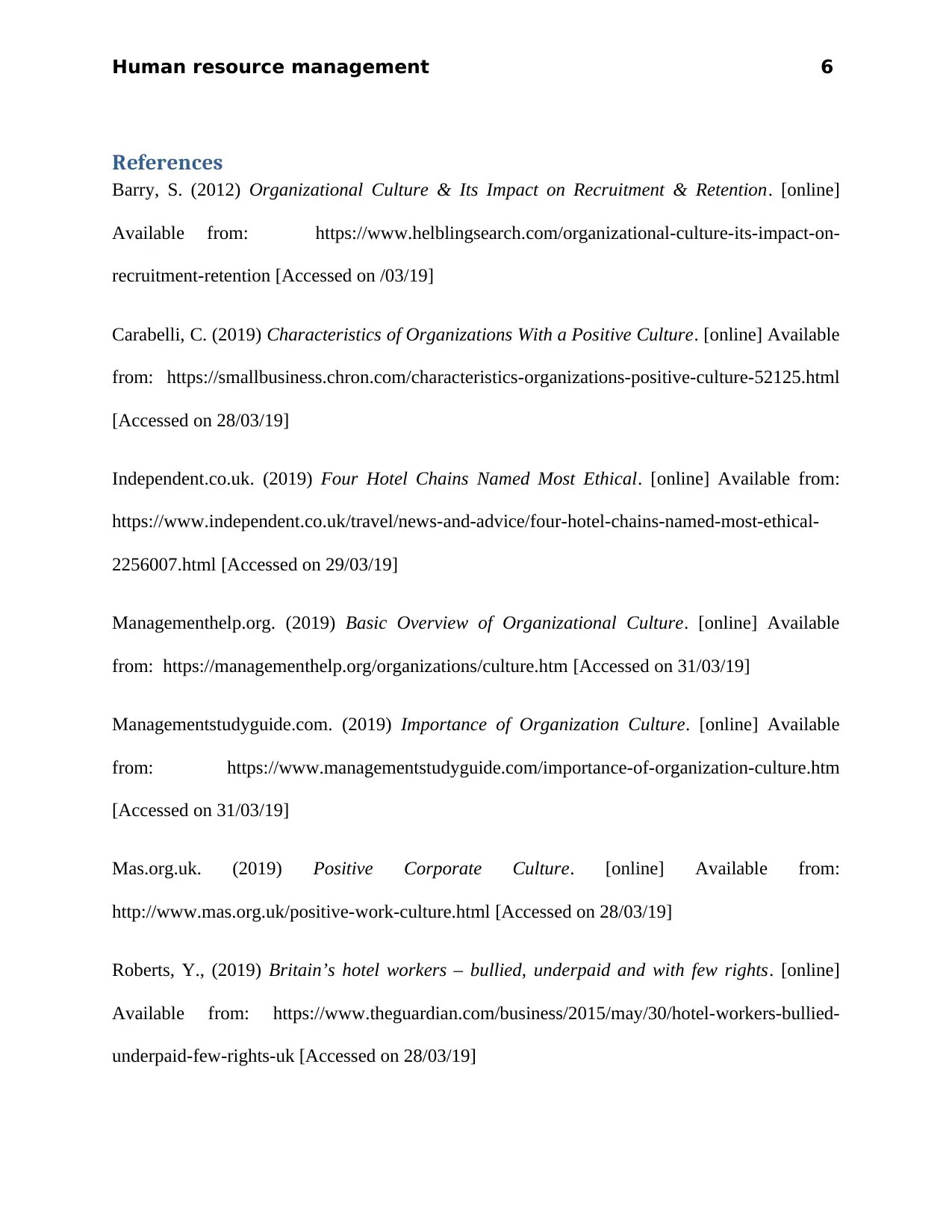
Human resource management 6
References
Barry, S. (2012) Organizational Culture & Its Impact on Recruitment & Retention. [online]
Available from: https://www.helblingsearch.com/organizational-culture-its-impact-on-
recruitment-retention [Accessed on /03/19]
Carabelli, C. (2019) Characteristics of Organizations With a Positive Culture. [online] Available
from: https://smallbusiness.chron.com/characteristics-organizations-positive-culture-52125.html
[Accessed on 28/03/19]
Independent.co.uk. (2019) Four Hotel Chains Named Most Ethical. [online] Available from:
https://www.independent.co.uk/travel/news-and-advice/four-hotel-chains-named-most-ethical-
2256007.html [Accessed on 29/03/19]
Managementhelp.org. (2019) Basic Overview of Organizational Culture. [online] Available
from: https://managementhelp.org/organizations/culture.htm [Accessed on 31/03/19]
Managementstudyguide.com. (2019) Importance of Organization Culture. [online] Available
from: https://www.managementstudyguide.com/importance-of-organization-culture.htm
[Accessed on 31/03/19]
Mas.org.uk. (2019) Positive Corporate Culture. [online] Available from:
http://www.mas.org.uk/positive-work-culture.html [Accessed on 28/03/19]
Roberts, Y., (2019) Britain’s hotel workers – bullied, underpaid and with few rights. [online]
Available from: https://www.theguardian.com/business/2015/may/30/hotel-workers-bullied-
underpaid-few-rights-uk [Accessed on 28/03/19]
References
Barry, S. (2012) Organizational Culture & Its Impact on Recruitment & Retention. [online]
Available from: https://www.helblingsearch.com/organizational-culture-its-impact-on-
recruitment-retention [Accessed on /03/19]
Carabelli, C. (2019) Characteristics of Organizations With a Positive Culture. [online] Available
from: https://smallbusiness.chron.com/characteristics-organizations-positive-culture-52125.html
[Accessed on 28/03/19]
Independent.co.uk. (2019) Four Hotel Chains Named Most Ethical. [online] Available from:
https://www.independent.co.uk/travel/news-and-advice/four-hotel-chains-named-most-ethical-
2256007.html [Accessed on 29/03/19]
Managementhelp.org. (2019) Basic Overview of Organizational Culture. [online] Available
from: https://managementhelp.org/organizations/culture.htm [Accessed on 31/03/19]
Managementstudyguide.com. (2019) Importance of Organization Culture. [online] Available
from: https://www.managementstudyguide.com/importance-of-organization-culture.htm
[Accessed on 31/03/19]
Mas.org.uk. (2019) Positive Corporate Culture. [online] Available from:
http://www.mas.org.uk/positive-work-culture.html [Accessed on 28/03/19]
Roberts, Y., (2019) Britain’s hotel workers – bullied, underpaid and with few rights. [online]
Available from: https://www.theguardian.com/business/2015/may/30/hotel-workers-bullied-
underpaid-few-rights-uk [Accessed on 28/03/19]
Paraphrase This Document
Need a fresh take? Get an instant paraphrase of this document with our AI Paraphraser
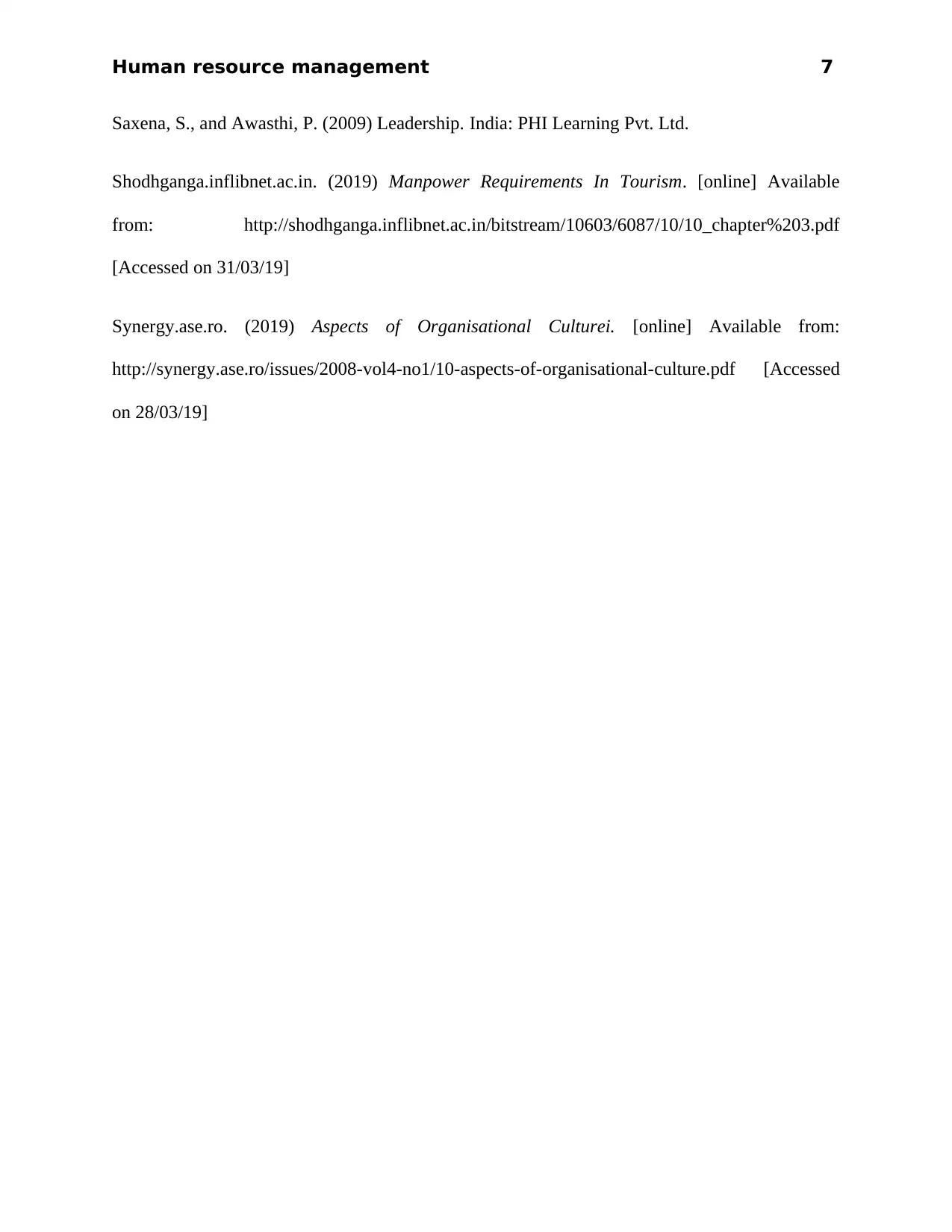
Human resource management 7
Saxena, S., and Awasthi, P. (2009) Leadership. India: PHI Learning Pvt. Ltd.
Shodhganga.inflibnet.ac.in. (2019) Manpower Requirements In Tourism. [online] Available
from: http://shodhganga.inflibnet.ac.in/bitstream/10603/6087/10/10_chapter%203.pdf
[Accessed on 31/03/19]
Synergy.ase.ro. (2019) Aspects of Organisational Culturei. [online] Available from:
http://synergy.ase.ro/issues/2008-vol4-no1/10-aspects-of-organisational-culture.pdf [Accessed
on 28/03/19]
Saxena, S., and Awasthi, P. (2009) Leadership. India: PHI Learning Pvt. Ltd.
Shodhganga.inflibnet.ac.in. (2019) Manpower Requirements In Tourism. [online] Available
from: http://shodhganga.inflibnet.ac.in/bitstream/10603/6087/10/10_chapter%203.pdf
[Accessed on 31/03/19]
Synergy.ase.ro. (2019) Aspects of Organisational Culturei. [online] Available from:
http://synergy.ase.ro/issues/2008-vol4-no1/10-aspects-of-organisational-culture.pdf [Accessed
on 28/03/19]
1 out of 8
Related Documents
Your All-in-One AI-Powered Toolkit for Academic Success.
+13062052269
info@desklib.com
Available 24*7 on WhatsApp / Email
![[object Object]](/_next/static/media/star-bottom.7253800d.svg)
Unlock your academic potential
Copyright © 2020–2025 A2Z Services. All Rights Reserved. Developed and managed by ZUCOL.





